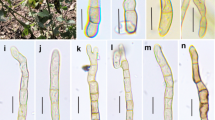Abstract
The largely tropical Podostemaceae occur in a unique habitat for angiosperms: attached to rocks in river rapids and waterfalls. Little taxonomic work has been published on New World Podostemaceae since Van Royen's monograph in the early 1950s. A paucity of complete herbarium material severely limits taxonomic study and precludes addressing a range of enigmatic ecological and evolutionary issues that relate to the family. The size, high level of endemism, and life history of the family are discussed. The distributions of two species in Mexico are used to illustrate the need for concerted collecting efforts. Recommendations for collection strategies are made that reflect the unusual habitat and life history of these plants.
Resumen
La familia Podostemaceae se desarrolla básicamente en los trópicos en un hábitat único para las angiospermas: adheridas a las rocas en ríos con cataractas y cachuelas. Se ha publicado muy pocos trabajos taxonómicos sobre las Podostemaceae del Nuevo Mundo desde que Van Royen publicó su monografía a principios de los años 1950s. La escasez de colecciones herborizadas completas, restringe severamente el estudio taxonómico, e impide señalar su alcance en cuestiones ecológicas y evolutivas que se relacionen a esta familia. Se discute el tamaño, nivel de endemismo, y historia de vida de la familia. Las distribuciones de dos especies en México son usadas para ilustrar la necesidad de llevar a cabo esfuerzos concertados para realizar nuevas colectas. Se hacen recomendaciones sobre los métodos de colecta que reflejen el hábitat insólito y la historia de vida de estas plantas.
Similar content being viewed by others
Literature Cited
Arber, A. 1920. Water plants. Cambridge University Press, London.
Barrett, S. C. H., D. G. Eckert &B. C. Husband. 1993. Evolutionary processes in aquatic plant populations. Aquatic Bot. 44: 105–145.
Burger, W. 1983. Podostemaceae. Pages 1–8.In: Flora Costaricensis, Fieldiana, Bot. 13: 1–255.
Ceska, A. &O. Ceska. 1986. More on the techniques for collecting aquatic and marsh plants. Ann. Missouri Bot. Gard. 73: 825–827.
Cook, C. D. K. 1990. Aquatic plant book. SPB Academic Publishing, The Hague.
Cusset, C. 1972. Les Podostemaceae de Madagascar. Adansonia 12: 557–568.
— 1973a. Révision des Hydrostachyaceae. Adansonia 13: 75–119.
— 1973b. Contribution a l'étude des Podostemaceae. III. Le genreStonesia. Adansonia 13: 307–312.
— 1980. Contribution a l'étude des Podostemaceae: 6. Les genresLeiothylax etLetestuella. Adansonia 20: 199–209.
— &G. Cusset. 1988. Étude sur les Podostemales. 9. Délimitations taxinomiques dans les Tristichaceae. Adansonia 10: 149–177.
Gardner, G. 1847. Observations of the structure and affinities of the plants belonging to the natural order Podostemaceae, together with a monograph of the Indian species. Calcutta J. Nat. Hist. 7: 165–189.
Gessner, F. &L. Hammer. 1962. Ökologische-physiologische Untersuchungen an den Podostemonaceen des Caroni. Int. Rev. Ges. Hydrobiol. 47: 497–541.
Grace, J. B. 1993. The adaptive significance of clonal reproduction in angiosperms: An aquatic perspective. Aquatic Bot. 44: 159–180.
Grubert, M. 1974. Podostemaceen-Studien. Teil II. Untersuchungen uber die Keimung. Bot. Jahrb. Syst. 95: 455–477.
Hammond, B. L. 1936. Regeneration ofPodostemum ceratophyllum. Bot. Gaz. (Crawfordsville) 97: 834–845.
Haynes, R. R. 1984. Techniques for collecting aquatic and marsh plants. Ann. Missouri Bot. Gard. 71: 229–231.
Haynes, R. R. 1984. In press. Podostemaceae.In: D. Stevens, editor. Flora de Nicaragua.
Les, D. H. 1988. Breeding systems, population structure, and evolution in hydrophilous angiosperms. Ann. Missouri Bot. Gard. 75: 819–835.
— &C. T. Philbrick. 1993. Studies of hybridization and chromosome number variation in aquatic angiosperms: Evolutionary implications. Aquatic Bot. 44: 181–228.
Novelo R., Novelo A. &C. T. Philbrick. 1993a.Vanroyenella: A new genus of Podostemaceae from Jalisco, Mexico. Syst. Bot. 18: 64–67.
—&—. 1993b. A new species ofMarathrum (Podostemaceae) from Jalisco, Mexico. Novon 3: 456–458.
Novelo R., A. & C. T. Philbrick. 1995. A new species ofOserya (Podostemaceae) from Jalisco, Mexico. Novon 5.
Philbrick, C. T. 1982. New locations forPodostemum ceratophyllum Michx. in New Hampshire and Maine with some comments on a unique floral form. Rhodora 84: 301–303.
— 1984. Aspects of the floral biology, breeding system, and seed and seedling biology ofPodostemum ceratophyllum (Podostemaceae). Syst. Bot. 9: 166–174.
— &G. E. Crow. 1983. The distribution ofPodostemum ceratophyllum Michx. (Podostemaceae). Rhodora 85: 325–341.
— &A. Novelo. 1994. Seed germination of Mexican Podostemaceae. Aquatic Bot. 48: 145–151.
Rutishauser, R. &K. A. Huber. 1991. The developmental morphology ofIndotristichia ramosissima (Podostemaceae, Tristichoideae). Pl. Syst. Evol. 178: 195–223.
Schultes, R. E. 1988. Where the gods reign: Plants and peoples of the Columbian Amazon. Synergetic Press, Oracle, AZ.
Sculthorpe, C. D. 1967. The biology of aquatic vascular plants. St. Martin's Press, New York.
Sioli, H. 1986. Tropical continental aquatic habitats. Pages 383–393.In: M. Soule, editor. Conservation biology. Sinauer Associates, Sunderland, MA.
Tur, N. M. 1975. Nueva especie de Podostemaceae para ArgentinaWettsteiniola apipiensis. Bol. Soc. Argent. Bot. 16: 320–324.
Van Royen, P. 1951. The Podostemaceae of the New World. Part I. Meded. Bot. Mus. Herb. Rijks Univ. Utrecht. 107: 1–151.
— 1953. The Podostemaceae of the New World. II. Acta Bot. Neerl. 2: 1–20.
— 1954. The Podostemaceae of the New World. III. Acta Bot. Neerl. 3: 215–263.
Vidyashankari, B. 1988. Developmental biology ofGriffithella hookeriana (Podostemaceae). Ph.D. dissertation. University of Dehli, India.
— &H. Y. Mohan Ram. 1987. In vitro germination and origin of the thallus ofGriffithella hookeriana (Podostemaceae). Aquatic Bot. 28: 161–169.
Went, F. A. F. C. 1929. Morphological and histological peculiarities of the Podostemaceae. Pages 351–358.In: Proceedings of the International Congress of Plant Sciences. Ithaca, NY.
Willis, J. C. 1902. Studies in the morphology and ecology of the Podostemaceae of Ceylon and India. Ann. Roy. Bot. Gard. (Peradeniya) 1: 267–465.
— 1914. A new natural family of flowering plants: Tristichaceae. J. Linn. Soc., Bot. 43: 49–54.
Author information
Authors and Affiliations
Rights and permissions
About this article
Cite this article
Philbrick, C.T., Alejandro, N.R. New World Podostemaceae: Ecological and evolutionary enigmas. Brittonia 47, 210–222 (1995). https://doi.org/10.2307/2806959
Issue Date:
DOI: https://doi.org/10.2307/2806959




